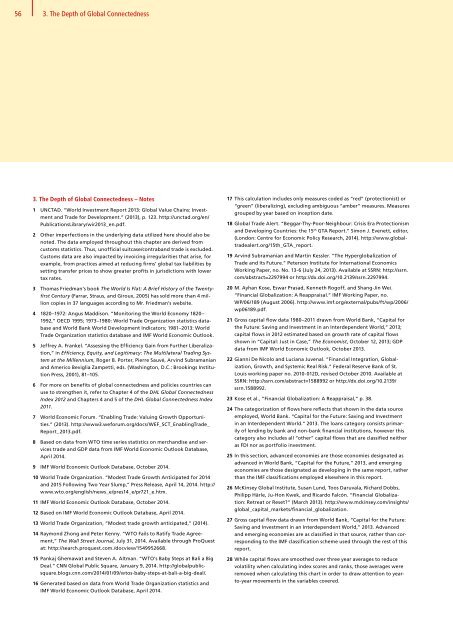DHL Global Connectedness Index 2014
DHL Global Connectedness Index 2014
DHL Global Connectedness Index 2014
- No tags were found...
Create successful ePaper yourself
Turn your PDF publications into a flip-book with our unique Google optimized e-Paper software.
56 3. The Depth of <strong>Global</strong> <strong>Connectedness</strong><br />
3. The Depth of <strong>Global</strong> <strong>Connectedness</strong> – Notes<br />
1 UNCTAD. “World Investment Report 2013: <strong>Global</strong> Value Chains: Investment<br />
and Trade for Development.” (2013), p. 123. http://unctad.org/en/<br />
PublicationsLibrary/wir2013_en.pdf.<br />
2 Other imperfections in the underlying data utilized here should also be<br />
noted. The data employed throughout this chapter are derived from<br />
customs statistics. Thus, unofficial suitcase/contraband trade is excluded.<br />
Customs data are also impacted by invoicing irregularities that arise, for<br />
example, from practices aimed at reducing firms’ global tax liabilities by<br />
setting transfer prices to show greater profits in jurisdictions with lower<br />
tax rates.<br />
3 Thomas Friedman’s book The World Is Flat: A Brief History of the Twentyfirst<br />
Century (Farrar, Straus, and Giroux, 2005) has sold more than 4 million<br />
copies in 37 languages according to Mr. Friedman’s website.<br />
4 1820–1972: Angus Maddison. “Monitoring the World Economy 1820–<br />
1992,” OECD 1995; 1973–1980: World Trade Organization statistics database<br />
and World Bank World Development Indicators; 1981–2013: World<br />
Trade Organization statistics database and IMF World Economic Outlook.<br />
5 Jeffrey A. Frankel. “Assessing the Efficiency Gain from Further Liberalization,”<br />
in Efficiency, Equity, and Legitimacy: The Multilateral Trading System<br />
at the Millennium, Roger B. Porter, Pierre Sauvé, Arvind Subramanian<br />
and Americo Beviglia Zampetti, eds. (Washington, D.C.: Brookings Institution<br />
Press, 2001), 81–105.<br />
6 For more on benefits of global connectedness and policies countries can<br />
use to strengthen it, refer to Chapter 4 of the <strong>DHL</strong> <strong>Global</strong> <strong>Connectedness</strong><br />
<strong>Index</strong> 2012 and Chapters 4 and 5 of the <strong>DHL</strong> <strong>Global</strong> <strong>Connectedness</strong> <strong>Index</strong><br />
2011.<br />
7 World Economic Forum. “Enabling Trade: Valuing Growth Opportunities.”<br />
(2013). http://www3.weforum.org/docs/WEF_SCT_EnablingTrade_<br />
Report_2013.pdf.<br />
8 Based on data from WTO time series statistics on merchandise and services<br />
trade and GDP data from IMF World Economic Outlook Database,<br />
April <strong>2014</strong>.<br />
9 IMF World Economic Outlook Database, October <strong>2014</strong>.<br />
10 World Trade Organization. “Modest Trade Growth Anticipated for <strong>2014</strong><br />
and 2015 Following Two Year Slump,” Press Release, April 14, <strong>2014</strong>. http://<br />
www.wto.org/english/news_e/pres14_e/pr721_e.htm.<br />
11 IMF World Economic Outlook Database, October <strong>2014</strong>.<br />
12 Based on IMF World Economic Outlook Database, April <strong>2014</strong>.<br />
13 World Trade Organization, “Modest trade growth anticipated,” (<strong>2014</strong>).<br />
14 Raymond Zhong and Peter Kenny. “WTO Fails to Ratify Trade Agreement,”<br />
The Wall Street Journal, July 31, <strong>2014</strong>. Available through ProQuest<br />
at: http://search.proquest.com./docview/1549952668.<br />
15 Pankaj Ghemawat and Steven A. Altman. “WTO’s Baby Steps at Bali a Big<br />
Deal.” CNN <strong>Global</strong> Public Square, January 9, <strong>2014</strong>. http://globalpublicsquare.blogs.cnn.com/<strong>2014</strong>/01/09/wtos-baby-steps-at-bali-a-big-deal/.<br />
16 Generated based on data from World Trade Organization statistics and<br />
IMF World Economic Outlook Database, April <strong>2014</strong>.<br />
17 This calculation includes only measures coded as “red” (protectionist) or<br />
“green” (liberalizing), excluding ambiguous “amber” measures. Measures<br />
grouped by year based on inception date.<br />
18 <strong>Global</strong> Trade Alert. “Beggar-Thy-Poor-Neighbour: Crisis Era Protectionism<br />
and Developing Countries: the 15 th GTA Report.” Simon J. Evenett, editor,<br />
(London: Centre for Economic Policy Research, <strong>2014</strong>). http://www.globaltradealert.org/15th_GTA_report.<br />
19 Arvind Subramanian and Martin Kessler. “The Hyperglobalization of<br />
Trade and Its Future.” Peterson Institute for International Economics<br />
Working Paper, no. No. 13-6 (July 24, 2013). Available at SSRN: http://ssrn.<br />
com/abstract=2297994 or http://dx.doi.org/10.2139/ssrn.2297994.<br />
20 M. Ayhan Kose, Eswar Prasad, Kenneth Rogoff, and Shang-Jin Wei.<br />
“Financial <strong>Global</strong>ization: A Reappraisal.” IMF Working Paper, no.<br />
WP/06/189 (August 2006). http://www.imf.org/external/pubs/ft/wp/2006/<br />
wp06189.pdf.<br />
21 Gross capital flow data 1980–2011 drawn from World Bank, “Capital for<br />
the Future: Saving and Investment in an Interdependent World,” 2013;<br />
capital flows in 2012 estimated based on growth rate of capital flows<br />
shown in “Capital: Just in Case,” The Economist, October 12, 2013; GDP<br />
data from IMF World Economic Outlook, October 2013.<br />
22 Gianni De Nicolo and Luciana Juvenal. “Financial Integration, <strong>Global</strong>ization,<br />
Growth, and Systemic Real Risk.” Federal Reserve Bank of St.<br />
Louis working paper no. 2010-012D, revised October 2010. Available at<br />
SSRN: http://ssrn.com/abstract=1588992 or http://dx.doi.org/10.2139/<br />
ssrn.1588992.<br />
23 Kose et al., “Financial <strong>Global</strong>ization: A Reappraisal,” p. 38.<br />
24 The categorization of flows here reflects that shown in the data source<br />
employed, World Bank. “Capital for the Future: Saving and Investment<br />
in an Interdependent World.” 2013. The loans category consists primarily<br />
of lending by bank and non-bank financial institutions, however this<br />
category also includes all “other” capital flows that are classified neither<br />
as FDI nor as portfolio investment.<br />
25 In this section, advanced economies are those economies designated as<br />
advanced in World Bank, “Capital for the Future,” 2013, and emerging<br />
economies are those designated as developing in the same report, rather<br />
than the IMF classifications employed elsewhere in this report.<br />
26 McKinsey <strong>Global</strong> Institute, Susan Lund, Toos Daruvala, Richard Dobbs,<br />
Philipp Härle, Ju-Hon Kwek, and Ricardo Falcón. “Financial <strong>Global</strong>ization:<br />
Retreat or Reset” (March 2013). http://www.mckinsey.com/insights/<br />
global_capital_markets/financial_globalization.<br />
27 Gross capital flow data drawn from World Bank, “Capital for the Future:<br />
Saving and Investment in an Interdependent World,” 2013. Advanced<br />
and emerging economies are as classified in that source, rather than corresponding<br />
to the IMF classification scheme used through the rest of this<br />
report.<br />
28 While capital flows are smoothed over three year averages to reduce<br />
volatility when calculating index scores and ranks, those averages were<br />
removed when calculating this chart in order to draw attention to yearto-year<br />
movements in the variables covered.





